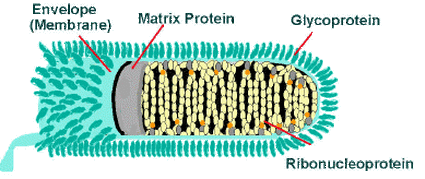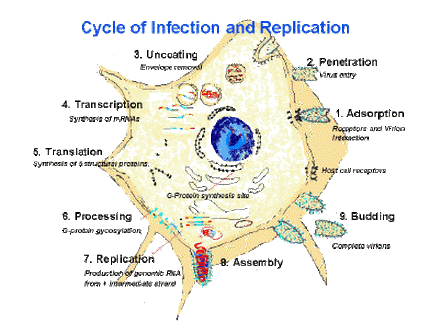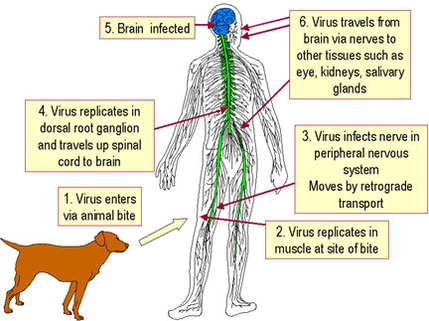Classification: (1)
Group- Group V
Order- Mononegavirales
viruses with non-segmented, negative stranded RNA genomes
Family- Rhabdoviridae
viruses with a distinct bullet shape
Genus- Lyssavirus
Species- Rabies virus
Group- Group V
Order- Mononegavirales
viruses with non-segmented, negative stranded RNA genomes
Family- Rhabdoviridae
viruses with a distinct bullet shape
Genus- Lyssavirus
Species- Rabies virus

Structure:
pic (1)
1) helical ribonucleoprotein core (RNP)
2) surrounding envelope
pic (1)
1) helical ribonucleoprotein core (RNP)
2) surrounding envelope
- In the RNP, genomic RNA is tightly encased by the nucleoprotein (1)
- The glycoprotein forms approximately 400 trimeric spikes which are tightly arranged on the surface of the virus (1)
- The matrix protein is associated with both the envelope and RNP and may be the central protein of rhabdovirus assembly (1)

Replication:
pic (1)
Replication of the rabies virus follows the progression for RNA virus replication described in the virus overview.
pic (1)
Replication of the rabies virus follows the progression for RNA virus replication described in the virus overview.

Transmission and Infection (4):
pic is (4)
Transmission
pic is (4)
Transmission
- The virus is harbored in saliva and is often transmitted via animal bites (rare cases: corneal/other tissue transplant, contact of infected saliva with mucosal membranes or an open wound in the absence of a bite, inhalation of aerosolized rabies virus)
- The virus binds to nerve or muscle cells at the site of the bite via nicotinic acetylcholine receptors
- It remains there for a prolonged period of time (several months)
- The virus multiplies in the muscle cells at the site of the bite without showing symptoms (incubation phase)
- Next, the virus moves a long nerve axons to the CNS using retrograde transport
- The virus arrives a the dorsal root ganglia and spinal cord then from there spreads to the brain (prodromal phase)
- Brain cells infected: cerebellum, purkinje cells, hippocampus, pontine nuclei
- Brain infection leads to encephalitis and neural degeneration, eventually leading to coma and death (neurological phase)
- During the neurological phase, the virus spreads from the CNS to the skin, eye, various other sites and the salivary glands via neurons
Symptoms in an Animal(5):
Stage 1:
Stage 1:
- loss of appetite
- a change in normal behavior, such as appearing unusually tame around strangers
- constantly barking or growling
- no fear of normal natural enemies
- attempting to attack and bite anything that comes near, including inanimate objects
- animal appears to be choking
- foaming at the mouth
- dropping of the lower jaw (dogs)
- paralysis of the jaw, mouth and throat muscles
Conservation Status (4):
- Canine rabies is most prevalent in Latin America, Asia and Africa
- Recently in the U.S. (1990-2004) 35 of 47 cases have been associated with bat rabies and 2 were dog/coyote-like strains acquired in the U.S. and 10 were dog/coyote-like strains acquired outside the U.S.
- Immunization of pets and quick response to bites from suspicious animals may explain why bat-transmission has been the predominant mode of transmission in recent years
- In the U.S., vaccination of animals has reduced the rate of the human disease to one case per year
- In India, there are 25,000 cases of human rabies per year
- In South America, rabies transmission by vampire bats poses a major problem for the cattle industry
Interesting Facts (3):
- Humans have been infected in rare cases after breathing in the air of bat caves
- The latin word rabies means madness and the sanskrit word rabhas means "to do violence"
- Until 1885 when the rabies vaccine was developed, all human cases of rabies were fatal
